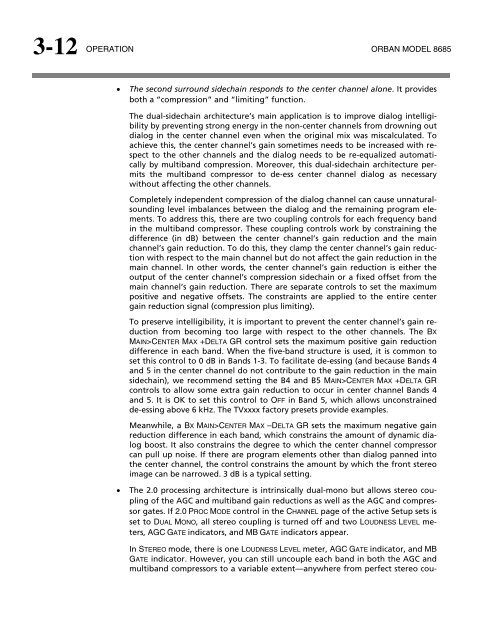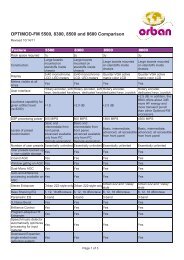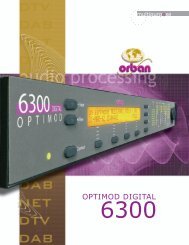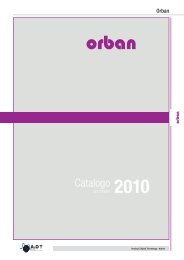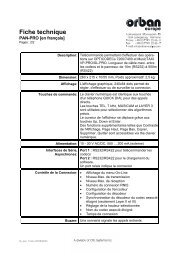Optimod-Surround 8685 V1.0 Operating Manual - Orban
Optimod-Surround 8685 V1.0 Operating Manual - Orban
Optimod-Surround 8685 V1.0 Operating Manual - Orban
You also want an ePaper? Increase the reach of your titles
YUMPU automatically turns print PDFs into web optimized ePapers that Google loves.
3-12<br />
OPERATION ORBAN MODEL <strong>8685</strong><br />
• The second surround sidechain responds to the center channel alone. It provides<br />
both a “compression” and “limiting” function.<br />
The dual-sidechain architecture’s main application is to improve dialog intelligibility<br />
by preventing strong energy in the non-center channels from drowning out<br />
dialog in the center channel even when the original mix was miscalculated. To<br />
achieve this, the center channel’s gain sometimes needs to be increased with respect<br />
to the other channels and the dialog needs to be re-equalized automatically<br />
by multiband compression. Moreover, this dual-sidechain architecture permits<br />
the multiband compressor to de-ess center channel dialog as necessary<br />
without affecting the other channels.<br />
Completely independent compression of the dialog channel can cause unnaturalsounding<br />
level imbalances between the dialog and the remaining program elements.<br />
To address this, there are two coupling controls for each frequency band<br />
in the multiband compressor. These coupling controls work by constraining the<br />
difference (in dB) between the center channel’s gain reduction and the main<br />
channel’s gain reduction. To do this, they clamp the center channel’s gain reduction<br />
with respect to the main channel but do not affect the gain reduction in the<br />
main channel. In other words, the center channel’s gain reduction is either the<br />
output of the center channel’s compression sidechain or a fixed offset from the<br />
main channel’s gain reduction. There are separate controls to set the maximum<br />
positive and negative offsets. The constraints are applied to the entire center<br />
gain reduction signal (compression plus limiting).<br />
To preserve intelligibility, it is important to prevent the center channel’s gain reduction<br />
from becoming too large with respect to the other channels. The BX<br />
MAIN>CENTER MAX +DELTA GR control sets the maximum positive gain reduction<br />
difference in each band. When the five-band structure is used, it is common to<br />
set this control to 0 dB in Bands 1-3. To facilitate de-essing (and because Bands 4<br />
and 5 in the center channel do not contribute to the gain reduction in the main<br />
sidechain), we recommend setting the B4 and B5 MAIN>CENTER MAX +DELTA GR<br />
controls to allow some extra gain reduction to occur in center channel Bands 4<br />
and 5. It is OK to set this control to OFF in Band 5, which allows unconstrained<br />
de-essing above 6 kHz. The TVxxxx factory presets provide examples.<br />
Meanwhile, a BX MAIN>CENTER MAX –DELTA GR sets the maximum negative gain<br />
reduction difference in each band, which constrains the amount of dynamic dialog<br />
boost. It also constrains the degree to which the center channel compressor<br />
can pull up noise. If there are program elements other than dialog panned into<br />
the center channel, the control constrains the amount by which the front stereo<br />
image can be narrowed. 3 dB is a typical setting.<br />
• The 2.0 processing architecture is intrinsically dual-mono but allows stereo coupling<br />
of the AGC and multiband gain reductions as well as the AGC and compressor<br />
gates. If 2.0 PROC MODE control in the CHANNEL page of the active Setup sets is<br />
set to DUAL MONO, all stereo coupling is turned off and two LOUDNESS LEVEL meters,<br />
AGC GATE indicators, and MB GATE indicators appear.<br />
In STEREO mode, there is one LOUDNESS LEVEL meter, AGC GATE indicator, and MB<br />
GATE indicator. However, you can still uncouple each band in both the AGC and<br />
multiband compressors to a variable extent—anywhere from perfect stereo cou-


